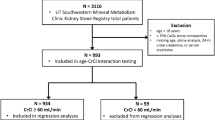Abstract
Hyperoxaluria is a well-recognised risk factor for urolithiasis and patients with primary hyperoxaluria (PH) gradually build up calcium oxalate deposits leading to chronic kidney disease. Efforts to improve treatment for PH have focused on reducing urine oxalate excretion and thus decreasing lithogenesis. To determine the efficacy of treatments designed to alter a biochemical parameter it is necessary to know the biological and analytical variation of that parameter. In this study, we estimated the intra-individual biological variation of urine oxalate excretion in patients with PH, and from this determined what would constitute a significant change in the form of a reference change value (RCV). Each patient collected four 24-h urines on consecutive weeks. The intra-individual biological variation of oxalate excretion calculated from these samples ranged from 0 to 36 % with a mean of 14 %. The corresponding RCVs were 4–84 % with a mean of 32 %. This result implies that, on average, a reduction of almost one-third in urine oxalate excretion is required to prove an effect from treatment. The wide range of biological variation between individuals may reflect other, as yet unknown, determinants of oxaluria in PH, as well as inaccuracies in urine collection. The data suggest that it is more appropriate to use individual RCVs established prior to treatment to determine its efficacy: a relatively small fall in urine oxalate excretion may be outside the biological variation of some patients but not of others.

Similar content being viewed by others
References
Cochat P, Rumsby G (2013) Primary hyperoxaluria. N Engl J Med 369(7):649–658
Hoppe B (2012) An update on primary hyperoxaluria. Nat Rev Nephrol 8(8):467–475
Monico CG, Rossetti S, Olson JB, Milliner DS (2005) Pyridoxine effect in type I primary hyperoxaluria is associated with the most common mutant allele. Kidney Int 67(5):1704–1709
Bergstralh EJ, Monico CG, Lieske JC et al (2010) Transplantation outcomes in primary hyperoxaluria. Am J Transplant 10(11):2493–2501
Vahlensieck EW, Bach D, Hesse A (1982) Circadian rhythm of lithogenic substances in the urine. Urol Res 10(4):195–203
Holmes RP, Goodman HO, Assimos DG (2001) Contribution of dietary oxalate to urinary oxalate excretion. Kidney Int 59(1):270–276
Balchin ZE, Moss PA, Fraser CG (1991) Biological variation of urinary oxalate in different specimen types. Ann Clin Biochem 28(Pt 6):622–623
Antonelli JA, Langman CB, Odom C, Poindexter J, Huet B, Pearle MS (2013) Defining variation in urinary oxalate in hyperoxaluric stone formers. J Endourol 27(12):1530–1534
Mosteller R (1987) Simplified calculation of body-surface area. N Engl J Med 317(17):1098
Harris EK (1974) Effects of intra-and interindividual variation on the appropriate use of normal ranges. Clin Chem 20(12):1535–1542
Williams HE, Wandzilak TR (1989) Oxalate synthesis, transport and the hyperoxaluric syndromes. J Urol 141(3 Pt 2):742–749
Holmes RP, Ambrosius WT, Assimos DG (2005) Dietary oxalate loads and renal oxalate handling. J Urol 174(3):943–947
Taylor EN, Curhan GC (2008) Determinants of 24-hour urinary oxalate excretion. Clin J Am Soc Nephrol 3(5):1453–1460
Robijn S, Hoppe B, Vervaet BA, D’Haese PC, Verhulst A (2011) Hyperoxaluria: a gut–kidney axis? Kidney Int 80(11):1146–1158
Lemann J, Pleuss JA, Worcester EM, Hornick L, Schrab D, Hoffmann RG (1996) Urinary oxalate excretion increases with body size and decreases with increasing dietary calcium intake among healthy adults. Kidney Int 49(1):200–208
Hoppe B, Danpure CJ, Rumsby G et al (1997) A vertical (pseudodominant) pattern of inheritance in the autosomal recessive disease primary hyperoxaluria type 1: lack of relationship between genotype, enzymic phenotype, and disease severity. Am J Kidney Dis 29(1):36–44
Cho MM, Yi MM (1986) Variability of daily creatinine excretion in healthy adults. Hum Nutr Clin Nutr 40(6):469–472
Bingham SA, Cummings JH (1985) The use of creatinine output as a check on the completeness of 24-hour urine collections. Hum Nutr Clin Nutr 39(5):343–353
Gowans EMS, Fraser CG (1988) Biological variation of serum and urine creatinine and creatinine clearance: ramifications for interpretation of results and patient care. Ann Clin Biochem 25(3):259–263
Von Schnackenburg C, Byrd D, Latta K et al (1994) Determination of oxalate excretion in spot urines of healthy children by ion chromatography. Eur J Clin Chem Clin Biochem 32(1):27–29
Clifford-Mobley O, Tims C, Rumsby G (2015) The comparability of oxalate excretion and oxalate:creatinine ratio in the investigation of primary hyperoxaluria: review of data from a referral centre. Ann Clin Biochem 52(1):113–121
Acknowledgments
The authors would like to acknowledge the investigating doctors who made the study possible: Bernd Hoppe, UKB Bonn; Pierre Cochat, CHU de Lyon; Rémi Salomon, Hopital Necker, Paris; Jérome Harambat, CHU, Bordeaux; Sally Hulton, Birmingham Children’s Hospital; William Van’t Hoff, Great Ormond Street Hospital, London; Shabbir Moochhala, Royal Free Hospital, London.
Funding
OxThera AB: This research has received funding from the European Union’s Seventh Framework Programme managed by REA-Research Executive Agency http://ec.europa.eu/research/rea (FP7/2007–2013) under Grant Agreement No. FP7-SME-2013.
Author information
Authors and Affiliations
Corresponding author
Ethics declarations
Conflict of interest
OxThera AB is a biopharmaceutical company with products in development for treating hyperoxaluria with bacteria and enzymes.
Rights and permissions
About this article
Cite this article
Clifford-Mobley, O., Sjögren, A., Lindner, E. et al. Urine oxalate biological variation in patients with primary hyperoxaluria. Urolithiasis 44, 333–337 (2016). https://doi.org/10.1007/s00240-016-0860-2
Received:
Accepted:
Published:
Issue Date:
DOI: https://doi.org/10.1007/s00240-016-0860-2




